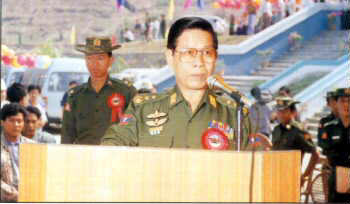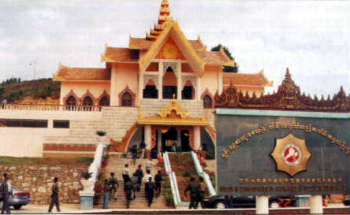Drugs suppression efforts of
special region (4) in eastern Shan State
 |
 |
| Secretary
(1) Lt-Gen Khin Nyunt addressing the opening ceremony of a museum commemorating the declaration of drug free zone in Mongla on 22 April 1997. |
The
museum commemorating the declaration of drug free zone in Mongla, Special Region (4), Eastern Shan State. |
The Burma Communist Party Military Region
(8-15) and Brigade (768) under the command of U Saing Lu split from the Burma
Communist Party in April 1989 and made peace with the Government. It was based
in Silu and Mongla in east Myanmar ear the Myanmar China border, which is widely
known as “The Golden Triangle” for its poppy cultivation. The
government designated that area as Special Region (4) and rendered assistance
and support for the development of the area and the elimination of poppy
cultivation. Since its peace with the government, the Special Region had
undertaken the development of the region at the same time when planned
eradication of poppy cultivation was being carried out. As a result, Special
Region (4) was able to decisively implement the plan for the eradication of
narcotic drugs. Mongla region, where there were previously 262 villages
cultivating opium on 2716 acres which yielded annually 8968 kilos of raw opium,
was declared to the world as “Opium Free Zone” at the inauguration
ceremony for a museum commemorating anti-drug activities.
The Special Region (4) had embarked on a 6-year plan for the eradication of
narcotics since 1992 with the assistance of the government and the UNDCP.
The Plan was composed of 3 two-year phases. First 2-year phase focused on
elimination of poppy cultivation in Monghe and Mongkhan with the second 2-year
phase concentrating on Monghe and Kyinkhan and the Third 2-year phase on Mongla,
Mongma, Silu, Mongkwe and Sangtauk with the objective of eradicating narcotic
drugs in the entire region and of preventing a relapse. Under the plan,
substitute crops were introduced to poppy growing areas with the government
providing necessary assistance to the local populace to help them meet the basic
needs before the substitute crops generated income.
In addition, establishment of income generating
enterprises for the local population and creation of other suitable business opportunities to generate
income for Eastern Shan State Special Region (4) forces were also included in the plan to put an
end to trafficking in narcotic drugs in the region.
In the initial stages after peace had been achieved, Special Region (4) carried out the
anti-narcotics activities under the leadership of the government. On 22 March 1994, Chairman of
Eastern Shan State Special Region (4) U Saing Lin and leading members, responsible personnel
from the Defense Services and Government departments and local population totaling 700
destroyed 45 acres of poppy fields and poppy seeds near Wanphyat village. Again on 5 May of
the same year 1 opium refinery, 60 kilos of heroin, 30 kilos of yellow heroin, 50 kilos of morphine, 30
viss of raw opium, chemicals, and paraphernalia were destroyed in Mongla under the supervision of state leaders and witnessed by personnel from International Organizations, United Nations Agencies and Embassies. The market value of the drugs destroyed was US $ 150 million.
On 3 July 1995, Eastern Shan State Special Region (4) issued a declaration prohibiting production and use of narcotic drugs in the region and use of the region as transit. The declaration also stated that drastic action would be taken against infringement of the prohibitions. Under the drugs suppression plan, 8515 grams of heroin, 950 grams of raw opium, proceeds from sale of narcotic drugs to the tune of Kyats 13.6 million and Kyats 20.0 million worth of properties from the defendants were seized in 1995, 1433 grams of heroin 1000 grams of raw opium and proceeds from sale of narcotic drug amounting
to Kyats 2.6 million were seized in 1996 and 4451 grams of heroin, 5275 grams of raw opium
5000 grams of opium seeds were seized in 1997.
On 14 January 1996, advisor from UNDCP Mr. Makhone, Mr. Hawk, departmental authorities of Mongyang Township
and a combined team of 40 members from Division 3654 of Eastern Shan State Special
Region (4), led by U San Aung, destroyed 1 acre of poppy fields near Wankyone (approximate LK
7037) and Yangkhan (approximate LK 7041). The consolidated Security Unit of the Special
Region (4) arrested drug traffickers during its drug suppression activities along the border.
The Special Region (4) laid emphasis on agriculture as alternative to opium poppy
cultivation and accordingly irrigation canals and dams were constructed. Development of virgin
land, distribution of quality seeds, encouragement of use of fertilizer and pesticides, provision of
agricultural training were also carried out for the development of agriculture. 1600 acres of sugarcane, 500 acres of watermelon, 400 acres of rubber in Mongla, over 170 acres under cardamom plants, 280 acres under rubber and tea plantations in Nanpang and 100 acres under tea and 1700 acres under castor and beans and groundnut were grown in Silu.
On 28 October 1997, Chairman U Saing Lin and the Secretary U Kyi Myint of the Special Region (4) met with responsible persons from the frontier unit of the People’s Republic of China and discussed the destruction of poppy, checking at border crossing and joint suppression of narcotic drugs. At 1205 hrs on 26 November 1997, 2 sections led by Second Lieutenant Khin Zaw Myo from Military Column 2, Company 3 of Infantry Regiment 328, and 5 members team led by major-level U Lon, Head of Division of the Judicial Department of the Special Region (4), destroyed half acre of poppy fields in Pangyang (approximately
P.940831). It is the objective of the region to go beyond the status of “Opium Free Zone” and to be
totally free of trafficking and use of opium, heroin and stimulants. In 1998, the drugs suppression unit
of the region established checkpoints at points of entry and exit and carried out searching and
inspection works. Acting on a tip-off,80,000 stimulant tablets were seized and traffickers were
arrested in Mongla on 18 September 1998.
Under the arrangement of the Ministry for Progress of Border Areas and National Races
and Development Affairs and the Ministry of Agriculture and Irrigation, buckwheat is being
grown as substitute crop in Laukkai, Kongkyan, Mongko, Kunlon, Hopan, Namkham, Lashio,
Tangyang. Cultivation of buckwheat as substitute crop in Kokang, Shan State commenced in 1996 in
cooperation with Japan. The successful harvest of buckwheat in that area on 30 November 1998
was observed by none other than by Secretary (1) of the State Peace and Development Council,
together with Ministers and guests. Previously, Kokang nationals, organized and exploited by the
Burma Communist for almost 20 years from 1968 to 1988, had adopted opium cultivation
as a livelihood. Now they have shifted, with the support and assistance of the Government, to
cultivation of annual and perennial crops. They have been growing rubber, sugarcane, buckwheat
and other crops in place of poppy. The development of present-day Laukkai as compared
to its previous condition is a sign of the successful and effective implementation of the development
of border areas and national races.
Mongla – The Drug Free Zone
Among the border areas where poppy is grown, Mongla is the only area proclaimed as “a totally drugs free zone”. It 1S located 46 miles east of Kengtung and was a huge village 10 years ago under the rule of the Burma Communist Party. The Government has designated it as “Special Region (4)” since 1991 and since then has undertaken development of the border areas and national races in the region with added momentum Hospital, clinics, schools, road and bridges, irrigation canals and dams hydro-electric power plants, post offices telephone exchanges, telegraphic
office, television relay stations, agricultural office and agricultural stations have
been established in the region. Since 1992 it has embarked on a 6-year plan for
the eradication of narcotic drugs in its area with the assistance of the government and
the UNDCP. At present, Mongla has developed to a city level, standing in splendor
with huge hotels, modern business centers religious edifices, pagodas and
stupas.
Proclamation of Special Region (4) a “Opium Free Zone” and establishment in Mongla of a museum commemorating that campaign against drug abuse were th3 success stories of Mongla. The government and local national races leaders joined hands to eradicate narcotic drugs
while undertaking efforts to develop the region and the social economic conditions of
the national races. These efforts consists of 3 phases. The first phase was for Nanpan while the second phase was in
Mongla and Mongla and the third phase in Silu respectively.